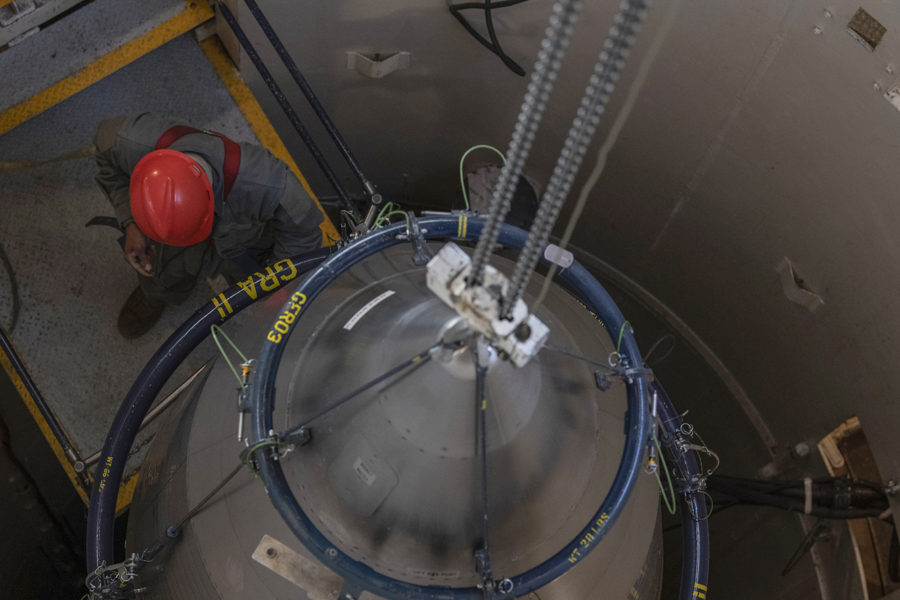Northrop Grumman will officially move ahead as the sole company in the Air Force’s competition to design a new intercontinental ballistic missile, under a $13.3 billion contract, the service said Sept. 8.
Northrop’s design for the Ground-Based Strategic Deterrent will replace the 400 Minuteman III missiles that are scattered in silos around Montana, North Dakota, and Wyoming, as well as 200 or so additional missiles used as replacements, for testing, and for other development.
The engineering and manufacturing development contract formally unseats Boeing as the Air Force’s future ICBM provider after more than 60 years as the primary contractor.
“With more than 65 years of technical leadership on every ICBM system, our nationwide team is honored and committed to continuing our partnership with the U.S. Air Force to deliver a safe, secure, and effective system that will contribute to global stability for years to come,” said Kathy Warden, Northrop’s chairman, chief executive officer, and president.
The contract covers weapon system design, qualification, test and evaluation, and nuclear certification, Northrop said in a Sept. 8 release. Missiles are supposed to be ready for initial deployment by 2029.
“Boeing supports the U.S. Air Force and its efforts to modernize the nation’s intercontinental ballistic missile force,” company spokesman Jerry Drelling said. “We will continue working alongside Airmen to keep the Minuteman ICBM mission-ready while delivering innovative solutions in support of strategic deterrence today and tomorrow.”
The Air Force will start construction to accommodate the new weapons at F.E. Warren Air Force Base, Wyo., as soon as 2023, followed by Malmstrom Air Force Base, Mont., in 2026, and Minot Air Force Base, N.D., in 2029. Northrop will begin delivering missiles in fiscal 2029 if the program remains on track.
Research and development is slated to cost nearly $22 billion overall, not including the cost of purchasing the missiles. An independent Pentagon cost estimate pegged the price tag around at least $85 billion, though it could eventually total much more.
The Air Force touts GBSD as a forward-looking program that is paving the way for new military techniques in three-dimensional printing and rapid software upgrades. Those features could make it possible to add a more maneuverable, hypersonic warhead in the future.
The missiles are expected to last until 2075 as the United States enters a new era in nuclear deterrence with Russia, China, North Korea, and other nuclear states.
“The increased accuracy, extended range, and improved reliability will provide the United States a broader array of options to address unforeseen contingencies, giving us the edge necessary to compete and win against any adversary,” Gen. Timothy M. Ray, head of Air Force Global Strike Command, said in a release.
GBSD is one piece of the Air Force’s broad effort to overhaul its nuclear arsenal. It is also buying a new nuclear bomber, Northrop’s B-21; buying new air-launched cruise missiles known as the Long-Range Standoff Weapon from Lockheed Martin or Raytheon; creating a new variant of the B61 gravity bomb; outfitting the F-35 Joint Strike Fighter to carry nuclear weapons; and designing a modern network to control and communicate with nuclear forces.
Minuteman III manufacturer Boeing announced last year it would pull out of the competition, ending its ICBM legacy, because it felt the odds were stacked in Northrop’s favor.
The Air Force “must address the unfair advantage that Northrop holds as a result of its control of solid rocket motors, the essential part of the GBSD missile system,” Boeing Defense CEO Leanne Caret wrote to the Air Force in July 2019. Northrop bought solid rocket motor builder Orbital ATK in 2017, around the time Boeing and Northrop won contracts to begin developing GBSD designs and prototypes.
Boeing and Northrop both worked with Aerojet Rocketdyne, the only other U.S.-based solid rocket motor supplier, and Orbital ATK before Orbital became Northrop Grumman Innovation Systems.
Despite wanting to keep two companies in the running to pick from a range of nuclear missile concepts, and ideally drive cost down, the Air Force opted to continue on without Boeing. That drew criticism from those who believed it would make the program less flexible and stifle the market.
“This contract provides the best overall value to the warfighter and taxpayers,” said Brig. Gen. Anthony W. Genatempo, commander of the Air Force Nuclear Weapons Center. “The GBSD program is leveraging technologies to reduce the program’s technical risk and ensure time-certain delivery to meet the warfighter’s needs.”
